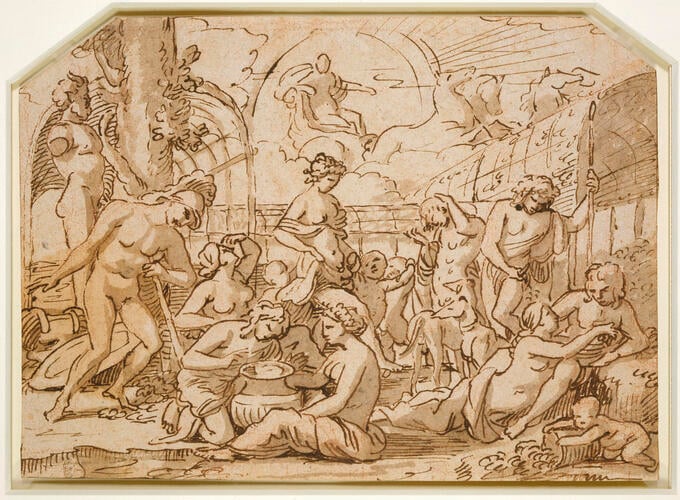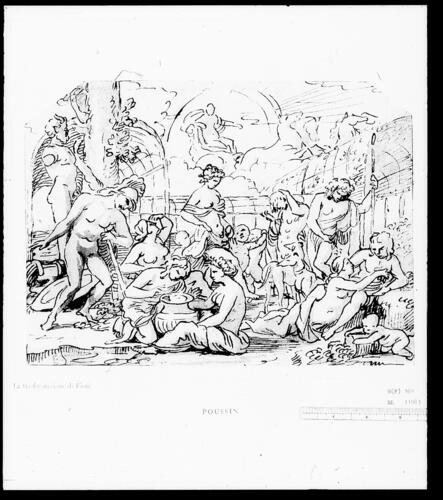-
1 of 253523 objects
The Realm of Flora c.1627
Pen and brown ink with brown wash over red chalk, on buff paper | 21.1 x 29.1 cm (sheet of paper) | RCIN 911983
-
A drawing of a bowered garden, with (l-r) Ajax falling on his sword; Clytia looking up at the sun; Narcissus gazing at his reflection with Echo by him; Flora holding her skirts and dancing, with putti, Hyacinthus holding his wounded head; Adonis showing his thigh, his dogs by his side; Crocus and Smylax. In the sky is Apollo in the chariot of the sun.
On the verso is a rough preparatory drawing in red chalk for the composition. Flora, surrounded by a ring of dancing putti, stands with both arms outstretched at the centre; Apollo rides his chariot through the sky, and the composition is framed by a tree on the left and a bower on the right. Ajax falls on his sword to the left, and before him are Crocus and Smilax. To the right the sketch becomes extremely rough, but a seated figure resting on its right elbow, not included in the final composition, may be discerned among the tangle of lines. Further rough and fragmentary red-chalk sketches for the composition are found on the verso of a drawing of Bacchus and Erigone in the Fitzwilliam Museum, Cambridge (Rosenberg & Prat 1994, no. 34).
At the trial for fraud of the Sicilian diamond dealer Don Fabritio Valguarnera in July 1631, Poussin testified that he had recently painted for Valguarnera "un giardino di Fiori". This can be identified with a canvas now in Dresden, generally known as the Realm of Flora, which depicts the goddess in a bowered garden, surrounded by figures whose legends account for the origins of certain flowers. The specific flowers produced often varied in different renderings of each myth, and attempts have been made to identify a source for the picture, in translations of Ovid's Metamorphoses or Fasti, or in G.B. Marino's poems Adone, Europa or La Rosa. But no one text fully accounts for all the features of the painting, and it must be regarded as a visual assemblage of stories rather than as an illustration of a single literary passage.
Reading from the left, we see Ajax, who threw himself on his sword and whose blood gave rise to a flower that varies from version to version, shown as a carnation in the Dresden painting; Clytie, who pining for the love of Apollo watched his sun-chariot cross the sky day by day, and turned into a sunflower or marigold; Narcissus, who was caused to fall in love with his own reflection as a punishment for spurning the affections of the water-nymph Echo (supporting the bowl), and who on his death was changed into the flower that bears his name; Flora herself, dancing in the drawing, strewing flowers in the painting; Hyacinthus, struck on the head by a discus thrown by Apollo, and whose blood yielded the hyacinth; Adonis, source of the anemone when his blood struck the ground after being gored in the thigh by a boar while hunting; and the lovers Crocus and Smilax, turned into the crocus flower and the yew respectively for their impatience.
It would be simplest to assume that the drawing is directly preparatory for the painting, and thus of late 1630 or early 1631, but there are difficulties with this. First, the drawing is one of a group of three illustrations of mythological transformations. En suite with the present sheet is a study for a depiction of Perseus and Andromeda: The Origin of Coral (RCIN 911984), and also in the Royal Collection are large, carefully drawn copies of these two compositions (911878-9) and a third, of Venus and Adonis Hunting: The Colouring of the Rose (911877). All of these compositions were described by Bellori (1672, pp. 441-3) without making it clear whether he refers to a painting or drawing of Flora. The three compositions must have been devised at the same time, but there is no indication that the painting in Dresden was ever intended to form part of a set, and it would be unusual for an artist to formulate two pendant compositions while devising a single projected painting.
The present drawing was thus probably conceived independently of the painting, In its handling of space it is closer to paintings such as the Louvre Triumph of Flora, of around 1627; the figure of Flora here is an exact reversal of Primavera in that painting (and the Flora on the verso, with arms outstretched, is in the pose of Flora in the Louvre painting). The claustrophobic composition of the drawing has been so expanded and lightened in the Dresden painting, and the spatial relationships between the figures have been so refined, that one must conclude that some time elapsed between the conception of the drawing and the execution of the painting.
The three compositions of The Realm of Flora, The Origin of Coral and The Colouring of the Rose were therefore probably conceived as an autonomous series around 1627. The three carefully finished versions of the compositions very probably came from the collection of Cassiano dal Pozzo, whose wide-ranging and erudite interest in antiquity and natural history is well known, and who was at this time beginning to assemble his enormous "Paper Museum", the bulk of which is now also at Windsor. Cassiano was one of Poussin's most supportive patrons in his early years, and nothing would be more natural than for him to commission from the young artist a set of finished drawings of what might be termed "mythological natural history".
This set of drawings may perhaps be connected with those mentioned in a letter from Poussin to Cassiano, undated but probably of 1627. Having referred to the composition of Hannibal on an elephant (Fogg Art Museum) that he was painting for Cassiano, Poussin wrote: "As to your drawings, I think of them every day, and soon I will finish something." This has been taken to refer to drawings after the antique for Cassiano's paper museum, but there is no hard evidence that Poussin contributed any such drawings, and it may be that the drawings of which he writes were finished figural compositions. The coincidence of the probable date of the letter with the date suggested by the style of 911983-4 might suggest that they were preparatory for the drawings mentioned in the letter.
The only problem is that the large finished drawings (911877-9) do not appear to be by Poussin. They are usually described simply as copies, and stylistically they are unlike anything certainly by Poussin known to us, with each line slowly and carefully drawn, and shaded with a combination of wash and fine parallel hatching replicating the effect of an engraving. Perhaps they are copies made for Cassiano by one of his stable of young draughtsmen, from originals, now lost, in his own collection; it is unlikely we will ever know.
The question remains of the circumstances in which the Dresden painting was commissioned. RCIN 911983-4 come from the Massimi collection and were therefore probably in Poussin's possession until at least the later 1630s, when Massimi took drawing lessons from the artist. Valguarnera appears not to have been in touch with Poussin until late 1630, but as he ordered the painting of the Plague at Ashdod (Louvre) around that time, it seems reasonable to suppose that he saw a drawing for the the Realm of Flora in Poussin's workshop and asked the artist to execute a painted version of the composition. Naturally, Poussin would revise the composition in the light of his developing aesthetic sense, thus explaining the increase in sophistication in the painting over the drawing.
A copy of the drawing is in a private collection in Paris (Rosenberg & Prat 1994, no. R966).Provenance
Cardinal Camillo Massimi (1620-1677); from whose heirs bought in 1739, for 300 scudi, by Richard Mead (1673-1754); probably presented to Frederick, Prince of Wales, by 1750.
-
Creator(s)
Acquirer(s)
-
Medium and techniques
Pen and brown ink with brown wash over red chalk, on buff paper
Measurements
21.1 x 29.1 cm (sheet of paper)
Other number(s)
RL 11983Alternative title(s)
La trasformatione de' Fiori


